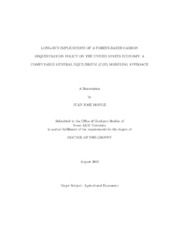| dc.description.abstract | The economic impacts of a government-funded, forest-based sequestration program were analyzed under two different payment schemes. The impacts were obtained by developing a regional, static CGE model built to accommodate a modified IMPLAN SAM for a determined region in the United States for 2008. The IMPLAN SAM was modified to accommodate the more conventional factors of production (labor, capital and land) and to account for land heterogeneity using the Major Land Resource Areas (MLRA). The regional aggregation considered included the Southern, Northeastern, Southwestern and Midwestern regions. The two policy scenarios considered consisted of two CO2-offset payment schemes: 1) the government compensates the generation of CO2-offsets only by the land converted to a carbon graveyard and 2) the government additionally compensates the CO2 offsets generated as a by-product by the existing commercial logging activity. By doing an analysis of the model with different budget magnitudes under the two scenarios, two different CO2-offset supply schedules were obtained with their respective CO2-offset price and quantity sets.
For a budget allocation of $6.9 billion, approximately 1 billion metric tons of CO2 offsets (15% of U.S. 2008 total GHG emissions) were produced in the first scenario versus 0.8 billion metric tons (11% of U.S. 2008 GHG net emissions) in the second one. Fifty million acres were diverted out of agriculture and commercial forestry land to the carbon graveyard mainly in the Northern, Western and Central Great Plains in the first scenario. Twenty two million acres were diverted out of agricultural land to the carbon graveyard and commercial logging mainly in the Northern and Western Great Plains; and the Eastern and Western boundaries of the Appalachian Mountains in the second scenario.
Both scenarios resulted in higher land and agricultural commodity prices, lower consumption of agricultural commodities by households, lower agricultural exports and higher imports. The payment structure of the second scenario benefited the commercial logging industry, increasing its production and exports, and decreasing its imports. The non-agricultural sectors mostly impacted by the two policy scenarios were the manufacturing, construction and government employment sectors. | en |


